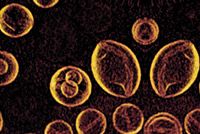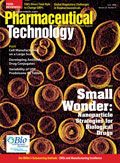Small Wonder: Nanoparticle Strategies for Biological Drugs
Nanoparticle-based systems present many advantages for the delivery of current and emerging biological drugs.
Anyone keeping abreast of industry trends in the pharmaceutical market has noticed the enthusiasm that drug developers, investors, and even traditional pharmaceutical companies have for biological drugs. Motivated as much by the technical and therapeutic promise of biologicals as by a diminished number of small-drug candidates in their pipelines, mainstream pharmaceutical companies are increasingly betting on large-molecule, biotechnically derived drugs.

Image Courtesy of Dr. P. Frederik and Mr. P. Bomans, University of Massstricht, The Netherlands and FEI Company.
In spite of their clinical promise and market potential, biological drugs present unique challenges for drug formulators and manufacturers. For example, their size and structure make these drugs difficult to deliver to the patient without stimulating an immune reaction. And the lability of these drugs makes it difficult to store them for any period of time.
To overcome these challenges, drug companies and researchers are devising many programs for delivering biologically based drugs. Among the most interesting are nanoparticle-based drug-delivery systems.
In February 2008, Upperton (Nottingham, UK), a biotechnology company specializing in spray-drying and particle technologies, and Novozymes (Bagsvaerd, Denmark) announced that they would commercialize their jointly-owned "rP-nano" technology. The technology uses the natural binding properties of recombinant protein nano-particles to provide targeted drug delivery and enhance bioavailability. The rP-nano technology produces nanoparticles from peptides and proteins, including monoclonal antibodies and enzymes, without denaturing them.
Andrew Yates, senior group leader of drug-product research and development with UCB (Brussels), says that polymeric nanoparticles "have the potential to change our way of thinking" about drug-product delivery. Ping Yeh, director of protein-pharmaceutical development at Biogen Idec (Cambridge, MA), explains that polymeric nanoparticles used for protein-drug delivery are often made of polysaccharides or poly(lactide-co-glycolide) copolymers. These small, colloidal particles can be about 50–1000 nm in size. When a manufacturer mixes a protein with a polymer, the polymer forms as a nanoparticle or sphere around the protein.
Providing protection
One benefit of polymeric nanoparticles is that they can maintain the stability of biological drugs, according to Anjan Nan, research assistant professor at the University of Maryland School of Pharmacy. Manufacturers can encapsulate or conjugate a protein drug in a nanoparticle to provide direct protection against unfavorable biological environments.
Coating nanoparticles' surface with biocompatible, water-soluble polymers such as polyethylene glycol makes them nonimmunogenic. This tactic also reduces the chance that the reticuloendothelial system of the body (i.e., the liver, spleen, and macrophages) will absorb the nanoparticles. The coating minimizes nonspecific adsorption effects such as protein binding. All of these effects enhance the stability of the biotech product, Nan explains. Safeguarding a drug's stability enhances its bioavailability and increases its effective half-life.
Hitting the target
Nanoparticulate drug delivery can target specific cells in the body, says Yates. "Engineering into the nanoparticle a strong specificity for certain types of cellular surface molecules allows for the provision of drug delivery to be specialized for a cell type," he explains. Thus, nanoparticles can be engineered to interact with specific organs, tissues, and even cells.
Nan says scientists can develop various linkers that enable nanoparticles to provide targeted drug delivery. One approach uses peptide linkers. The choice of the constituent amino acids depends on where the drug must be released. If a drug must be released inside a cell but be stable in the bloodstream, scientists can use a glycine–phenylalanine–leucine–glycine sequence. This sequence is stable in the blood, Nan says, because blood lacks the specific enzymes that lyse it.
Once the drug and carrier are internalized into the cell, they are taken into compartments called lysosomes, where proteases break down the peptide. This process releases the protein drug into the cell's interior.
Linkers that are susceptible to acid degradation can provide targeted delivery in certain applications. For example, the pH of the solution around a tumor is slightly more acidic than physiological pH, Nan explains. If a bond (e.g., an ester bond) is susceptible to hydrolysis, it becomes even more susceptible as the environmental acidity increases. A nanoparticle can be linked to a protein drug with such a bond. Thus a tumor can absorb a delivery mechanism, which becomes hydrolyzed in that acidic environment and releases the drug it carries. "You can get various degrees of controlled release just by changing the chemistry by which you attach your biomolecule to your macromolecular carrier," Nan says.
Because scientists can create nanoparticles that may specifically target certain cells, they also have the option of making a generic range of nanoparticle delivery systems for commonly targeted tissue types. "This method would reduce development costs significantly and provide a highly specific treatment," says Yates.
An additional benefit of a nanoparticle's ability to provide targeted drug delivery is the potential decrease in the side effects brought about by its biomolecular payload. "This decrease in side effects is of particular interest when dealing with the complex signaling problems involved with inflammation disorders and oncology diseases," Yates says.
Assuming control
Merrill Goldenberg, a scientific director at Amgen (Thousand Oaks, CA), notes that polymeric nanoparticles are also useful because scientists can change their properties to modify a drug's release profile. This technique can reduce bursts in dosage, for example.
QLT's (Vancouver, Canada) "Eligard" treatment for advanced prostate cancer is an example of this strategy. The active ingredient, leupromide (leutinizing hormone-releasing hormone) acetate, is comixed with the company's proprietary "Atrigel" copolymer. Atrigel is poly (DL-lactide-co-glycolide, PLGH), a biocompatible and biodegradable polymer that provides controlled release of leupromide. Eligard was first approved in 2002 in the United States and is also approved in seven other countries.
The protein must diffuse out of the polymer's matrix to reach its target. The polymer matrix can be tailored to release the protein over a period of days or months, says Yeh. This method of protein delivery provides more control than a bolus injection, which doesn't enable regulation of the drug release, he adds.
Sustained-release technology helps control the pharmacokinetic profiles and bioavailability of potent molecules needed in small concentrations. Cynthia Oliver, vice-president of process biochemistry and formulation sciences at MedImmune (Gaithersburg, MD), explains that polymers are used as a suspending matrix for encapsulated proteins. Biodegradable linkages allow polymers to release proteins through slow dissolution under physiological conditions. "It takes extensive experimentation to develop these technologies," she adds.
Nan describes a different way that polymeric nanoparticles can provide sustained release. Mucoadhesive polymers such as carbopol and polyacrylic acid increase the viscosity of a drug solution. Thus, when the drug is injected subcutaneously or transmitted intradermally through a patch, it forms a local depot that slowly releases the active molecule.
This method of sustained release reduces a drug's immunogenicity, Nan adds. If a drug is released at a fast rate in a local area, the body sends defense mechanisms such as macrophages or leukocytes to degrade the molecule. If the same molecule is released at a slow rate and does not exceed the minimum effective level in the blood, the body doesn't evoke that particular immune response. "It might be, over time, a lot more beneficial to release a lower concentration at a much slower rate," says Nan.
Companies that specialize in biopharmaceuticals are not the only ones that can produce polymeric nanoparticles. This delivery mechanism is produced by conventional processes typically found in most pharmaceutical companies, notes Frank Sorgi, vice-president of research and development at DPT (San Antonio, TX). "This factor allows the biologic API to be treated as if it were any other pharmaceutical," he says. Small-molecule companies and contractors routinely create nanoparticlate delivery systems, too.
Charging ahead
Recently, drug formulators have been experimenting with dendrimers: spherical polymers about 2–10 nm in size. A dendrimer's charge can be determined by the composition of different amine groups on its surface. The charge can in turn dictate the dendrimer's use.
For example, says Nan, positively charged dendrimers can be used in gene therapy by attracting and binding with negatively charged DNA. This interaction "not only makes the entire polymer–DNA complex compact, it also, because of its overall positive charge, has the likelihood of interacting with the cell membranes, which are slightly negative." The positive charge of the polymer–DNA complex facilitates endocytosis, the process by which the cell absorbs the complex. Scientists choose the dendrimer with the appropriate charge to ensure that it is absorbed by the particular target cell.
Treating diseases
Nanoparticulate delivery systems have several applications for cancer treatment, notes Oliver. Some binding ligands are tumor-specific and selectively target specific tissue or tumor types. Using site-specific ligands is a way to enhance a drug's bioavailability, she adds.
Nanoparticles can also be used to package other types of anticancer agents such as siRNA, Oliver says. Besides delivering therapies, nanoparticles can be designed as imaging agents.
In addition to cancer, scientists can treat diseases of the central nervous system by designing nanoparticles that deliver drugs across the blood-brain barrier. Diseases of the spleen or liver can likewise be treated with nanoparticles that target phagocytic cells of the reticuloendothelial system.
Conclusion
Nanoparticulate drug-delivery systems are increasingly viewed as an advantageous solution for biological drugs. This technique can mitigate some of these drugs' unique problems by safeguarding stability and preserving protein structure. In addition, nanoparticles provide efficient treatment by enabling targeted delivery and controlled release. This method of drug delivery, like most others, requires attention to certain manufacturing and biological considerations to be successful. Judging by the current interest and previous successes, however, nanoparticulate drug-delivery systems seem to be a viable and promising strategy for the biopharmaceutical industry.
For more on this topic, see "A Broad Palette for Biological Drug Delivery"

Drug Solutions Podcast: A Closer Look at mRNA in Oncology and Vaccines
April 30th 2024In this episode fo the Drug Solutions Podcast, etherna’s vice-president of Technology and Innovation, Stefaan De Koker, discusses the merits and challenges of using mRNA as the foundation for therapeutics in oncology as well as for vaccines.